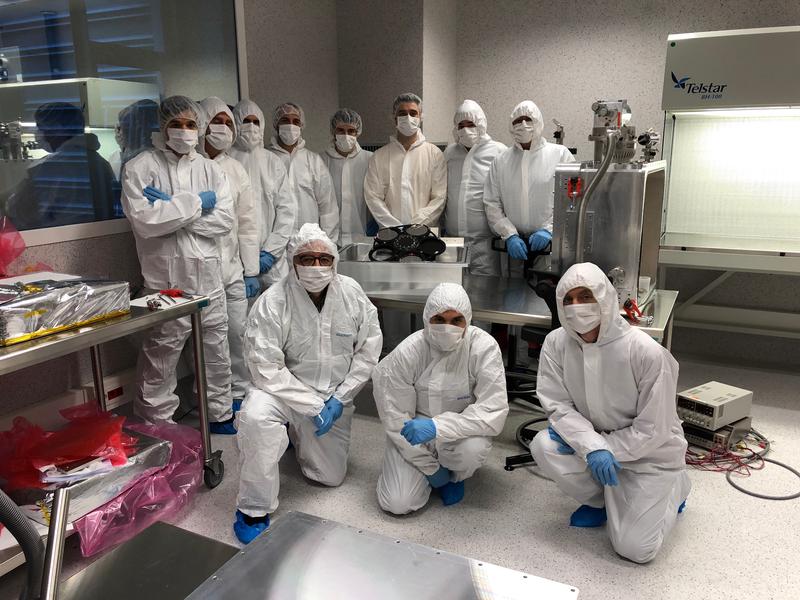Highlight
The Euclid telescope takes off to explore the dark universe
June 30, 2023

The European Space Agency (ESA) Euclid mission will launch into space on Saturday, July 1st, with an alternative date of July 2nd, on a SpaceX Falcon 9 rocket from Cape Canaveral Station in Florida, USA. The Institute of Space Sciences (ICE-CSIC), together with the Institute for Space Studies of Catalonia (IEEC) and the Institute of High Energy Physics (IFAE), have worked for more than 11 years on this mission. The launch will be broadcast live by ESA here .
Euclid will help us understand the nature of dark matter and energy which, according to the latest studies, make up around 95% of the matter and energy content in the universe. This dark matter and energy affect the movement and distribution of visible sources, such as galaxies, but do not emit or absorb light. Therefore, scientists have not yet been able to determine what they are. Understanding its nature is one of the most important challenges in cosmology today.
“Euclid will observe billions of galaxies up to distances of 10 billion light years, creating a very precise 3D map of a third of the sky”, comments Francisco Castander, a researcher from the ICE-CSIC, the IEEC and member of the Euclid Consortium. “By precisely measuring the position and shapes of galaxies in visible light and inferring their distances, Euclid will help us explore how the universe has expanded and how its structure has formed throughout cosmic history, which may reveal more about the role of gravity and the nature of dark energy and dark matter."
After a month of space travel, Euclid will reach its destination to orbit at the second Lagrange point (L2) of the Sun-Earth system, 1.5 million km from Earth in the opposite direction to the Sun. There, Euclid’s solar panels will have the double mission of capturing solar energy to supply it with energy and at the same time blocking sunlight at all times to be able to point its telescope towards deep space, ensuring a high level of stability for its instruments. Then, it will spend about two months running various tests to check that all its components and instruments are working properly. Finally, about three months after liftoff, Euclid will begin mapping the dark universe during the six-year that the mission is expected to last.
Spanish contribution to Euclid’s instrumentation
Euclid has a 1.2 meter diameter telescope and two instruments on board: VIS (VISible instrument) and NISP (Near-Infrared Spectrometer and Photometer). The latter is a near-infrared spectrometer and photometer, which has been developed thanks to extensive Spanish participation.
On the one hand, the ICE-CSIC, the IFAE and the IEEC have been involved since 2006 in the initial concepts of the mission and have been responsible for the design, construction, assembly and validation tests of the Filter Wheel Assembly (FWA) of the NISP instrument. This filter wheel is a mobile and delicate space instrumentation device that has required the development of sophisticated high-tech quality control and verification systems.

“The Barcelona group, as we are known within the Euclid Consortium, has done a lot of work in our labs to make sure that the filter wheel performs optimally under the conditions in which it will be operating in space,” comments Cristóbal Padilla, IFAE researcher and member of the Euclid Consortium. The filter wheel is a very important element that will allow us to determine the distances of galaxies up to billions of light years, that is, “it gives us the third dimension,” adds Padilla.
The Polytechnic University of Cartagena (UPCT), in collaboration with the Instituto de Astrofísica de Canarias (IAC), has been responsible for the design, construction and validation of the control electronics of the NISP Instrument.
“The control unit is in charge of starting the scientific instrument, maintaining the appropriate temperature for its correct operation, controlling the movements of the wheels and the calibration lamp, and monitoring the telemetry that will allow us to react in case of anomalies,” highlights Rafael Toledo, researcher responsible for the payload at the UPCT.
In addition, around 80 European companies participate in Euclid, of which 9 are Spanish, including Airbus, Alter Technology, Crisa, Deimos Space, GTD, Navair, Sener and Thales Alenia Space Spain.
Euclid’s scientific exploitation
ICE-CSIC and the Port d’Informació Científica (PIC), a center managed by IFAE and the Center for Energy, Environmental and Technological Research (CIEMAT), have been responsible for the mission´s cosmological simulations that have served to study its optimization and prepare the software for data processing and analysis. In addition, the PIC is the mission’s scientific data center in Spain. The ICE-CSIC and the IEEC also coordinate the predictions of the cosmological models of the main observables of the mission, which are the effects of gravitational lensing and the grouping of galaxies. Furthermore, IFAE, ICE-CSIC and IEEC participate in the measurements of the redshifts and distortions observed in distant galaxies.
Euclid is composed of more than 300 international institutions and more than 2,000 scientists from 13 European countries, the United States, Canada and Japan, who will benefit for decades from the exploitation of Euclid data to continue deepening our knowledge about dark energy and dark matter, the acceleration of the universe and how gravity works, among others. In more than 20 Spanish institutions, there are around 100 scientists preparing the scientific exploitation of the mission to unravel the mysteries of the dark universe.
“Euclid’s launch is just the beginning. It has been more than 11 years of hard work by more than 300 institutions from 13 European countries, the United States, Canada and Japan to get here. The answers we get will benefit the scientific community for decades. Euclid will revolutionize our understanding of the cosmos”, concludes Francisco Castander.
- IFAE Research group
- Observational Cosmology Group
- Contact
